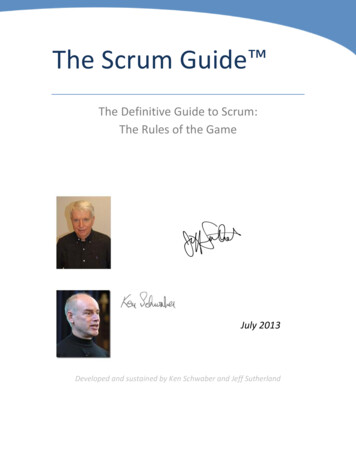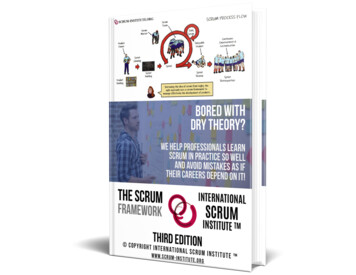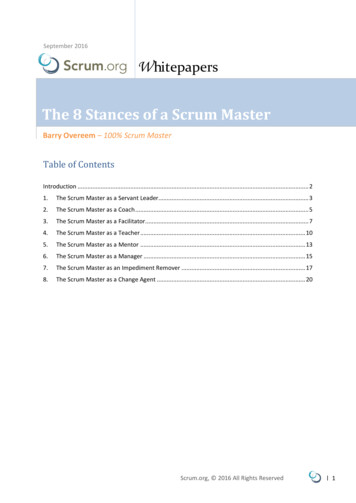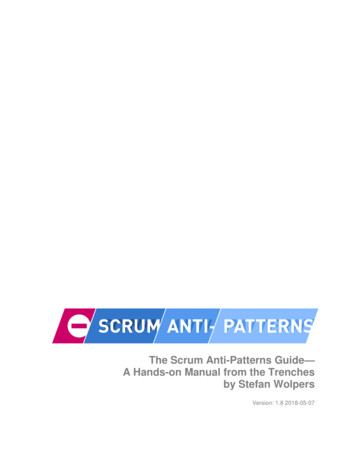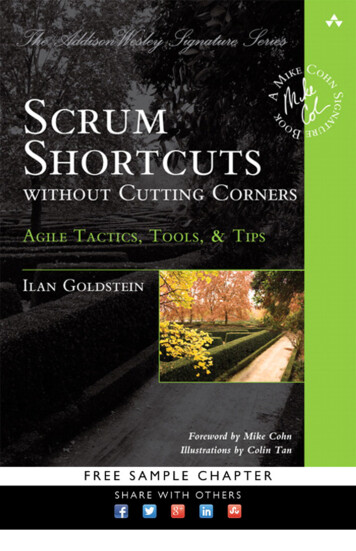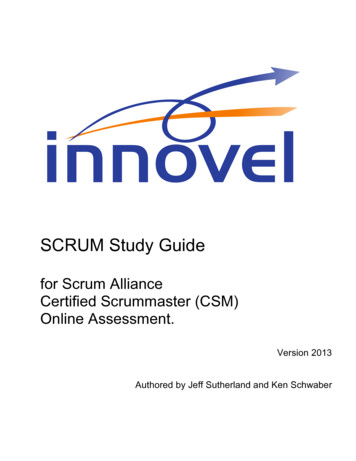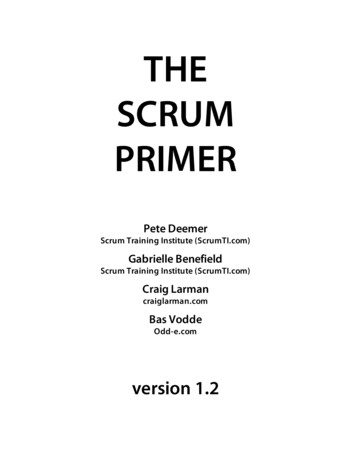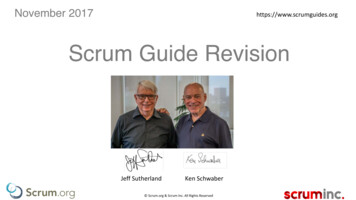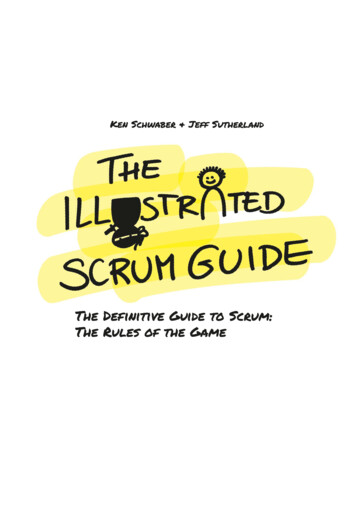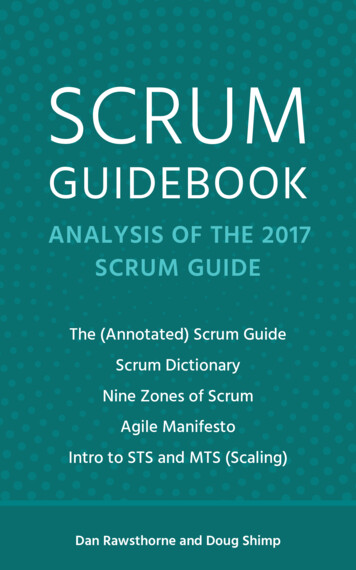
Transcription
SCRUMGUIDEBOOKANALYSIS OF THE 2017SCRUM GUIDEThe (Annotated) Scrum GuideScrum DictionaryNine Zones of ScrumAgile ManifestoIntro to STS and MTS (Scaling)Dan Rawsthorne and Doug Shimp
“We make sense of the world through mentalmodels, not just accumulating facts. Mentalmodels help us recognize patterns. A goodmodel allows us to see different things everytime we look at it! The best mental models aresimple, flexible, and open enough to capturecomplex situations and encourage us to seemore, and ask better questions.”- Marc Applebaum, PhDGuidebook: Analysis of the 2017 Scrum Guide 3Back LLC
iiMany of the designations used by manufacturers and sellers todistinguish their products are claimed as trademarks. Where thesedesignations appear in this book and the authors were aware of atrademark claim, the designations have been printed in initial caps, allcaps, or with appropriate registration symbols.The authors have taken care in the preparation of this document, butmake no expressed or implied warranty of any kind and assume noresponsibility for errors or omissions. No liability is assumed forincidental or consequential damages in connection with or arising outof the use of the information contained herein.‘Get To Done’ is a registered Trademark of Get To Done, LLC‘Scrum Dictionary’ is a registered Trademark of ScrumZone.org, whichis an organization focused on Organizational Scrum: Single-Team andMulti-Team.Book Design by Tuna Traffic, LLC.This Scrum Guidebook 2019, 3Back LLC, except for “The (Annotated)Scrum Guide” which is copyrighted as follows:- Scrum Guide 2017 Scrum.Org and ScrumInc- Annotations 2018, 2019 3Back LLCAll Copyrights are offered for license under the Attribution Share-Alikelicense of Creative Commons, accessible galcode and alsodescribed in summary form athttp://creativecommons.org/licenses/by-sa/4.0/. By utilizing thisScrum Guidebook you acknowledge and agree that you have read andagree to be bound by the terms of the Attribution Share-Alike licenseof Creative Commons.First Edition publication date: January 15, 20197th Version publication date: September 6, 2019ISBN-13: 9781794186989Scrum Guidebook: Analysis of the 2017 Scrum Guide 3Back LLC
iiiSCRUMGUIDEBOOKANALYSIS OF THE 2017SCRUM GUIDEDan Rawsthorne, PhD, CSTChief Scientist, 3Back LLCScrumZone.orgDoug Shimp, CSTPresident, 3Back LLCScrumZone.orgThe (Annotated) Scrum GuideScrum DictionaryNine Zones of ScrumThe Agile ManifestoIntro to STS and MTS (Scaling)Scrum Guidebook: Analysis of the 2017 Scrum Guide 3Back LLC
ivContents of GuidebookAnalysis of the 2017 Scrum Guide . 1The (Annotated) Scrum Guide . 15Scrum Dictionary . 87Nine Zones of Scrum . 122The Agile Manifesto . 123Single-Team Scrum (STS) . 125Multi-Team Scrum (MTS) . 126Acknowledgements . 128Scrum Guidebook: Analysis of the 2017 Scrum Guide 3Back LLC
Analysisthe20172017 ScrumGuideAnalysisofoftheScrumGuideDan Rawsthorne, PhD, CST, and Doug Shimp, CST3Back LLC, ScrumZone.orgTable of ContentsPurpose of Analysis. 1The Scrum Guide Simplifies the Problem . 2There are Two Definitions of Product . 2Scrum Guide uses the ‘Small Project’ Strategy . 7Other Important Results of the Analysis. 8The Need for a Business Owner . 8Better Understanding of the Sprint Goal . 10Better Understanding of What “Done” is . 10The Scrum Master Finally has some Authority . 11Conclusion . 12Purpose of AnalysisIn practice, Scrum is a vague concept. There are manydifferent, incompatible, kinds of Scrum; and for each of thesekinds of Scrum, there can be different descriptions. We likethe Scrum that is described in the 2017 Scrum Guide, but wefind the description to be lacking. We wrote the ScrumHandbooks (both STS and MTS) in order to provide a differentdescription of Scrum, that was true to the Scrum of the ScrumGuide, but whose description is more useful for Organizationstrying to use Scrum.So, in order to verify that we ‘got the Scrum right,’ weanalyzed the 2017 Scrum Guide, and made an annotatedversion of it for people to review. There are over 60Guidebook: Analysis of the 2017 Scrum Guide 3Back LLC
2annotations, and each contains one or more observationsmade about what we find in the Scrum Guide. Throughout thisanalysis, you will see references to these Annotations, whichare found in “The (Annotated) Scrum Guide,” which is includedin its entirety in the second section of this book.The Scrum Guide Simplifies the ProblemThe 2017 Scrum Guide provides a description of Scrumtailored to the following situation: A single Scrum Team delivering a single Product to asingle group of Stakeholders; whereEach Sprint is treated as a ‘Small Project’ that has ananticipated result.As our experience (and the Scrum Guide itself) shows, this isnot the only situation that Scrum pertains to. The followingsub-sections of this analysis address the Scrum Guide’streatment of these two issues.There are Two Definitions of ProductThere are two types of Products defined in the Scrum Guide.The first type is the one we usually think of: a Product issomething we build and deliver to customers and users. TheseProducts are deliverables that have Stakeholders, requirements, users, schedules, budgets, and so on they are exactlywhat we think they should be. For the sake of this analysis, Iwill call these products “Product-Products”, because they arethe Products we normally think of as Products.But, because Scrum is about Teams, and the Scrum Guide isabout Scrum, the Scrum Guide defines another type ofProduct – one that is Team-focused. This product consists ofScrum Guidebook: Analysis of the 2017 Scrum Guide 3Back LLC
3“the deliverables that result from the Development Team’swork” (see Annotation 11), and we will refer to this as a“Team-Product”, since each Dev Team (and each Scrum Team)produces exactly one of them.Now, the relationship between Product-Products and TeamProducts is straightforward: More than one Team’s Team-Product can contributedeliverables to a single Product-Product, orA single Team-Product can contribute deliverables tomore than one Product-Product.In general, there is a many-to-many relationship betweenTeam-Products and Product-Products (see Figure 1). Exceptfor a short paragraph about two Teams working on the sameProduct (Annotation 51), the Scrum guide is completely silentabout this issue. That does not mean there is no issue Figure 1: The Relationship between Team-Products andProduct-ProductsThe Scrum Guide says that every Product has a ProductBacklog, which is “an ordered list of everything that is knownto be needed in the product” and a single Product Owner, whois “responsible for the Product Backlog, including its content,availability, and ordering” (Annotation 49). For ProductProducts, this is all the Scrum Guide says. For Team-Products,however, the Scrum Guide is more explicit:Scrum Guidebook: Analysis of the 2017 Scrum Guide 3Back LLC
4 The Team-Product Owner is the Scrum Team Memberwho is accountable for the Development Team gettingtheir Work to “Done” (including technical Quality),and maximizing the value of that work – whether itproduces Team-Product or not. (Annotations 11 and14). The Team-Product Owner is not just about theTeam-Product and its technical Quality, but also aboutall the work the Development Team does Even further, the Team-Product Backlog is expandedto include all the work the Scrum Team is doing,whether or not the work is creating Team-Product(Annotation 15). So, the Team-Product Backlogshould, more appropriately, be called the ‘Team WorkBacklog’, which includes all the work the Scrum Teamdoes, including non-deliverable work done by theDevelopment Team (Spikes, Analysis, internal Training,etc.), the Scrum Master, and the Product Owner.Figure 2 shows a complete picture of the relationshipsbetween different kinds of Products, Product Backlogs, andProduct Owners.Figure 2: The Complete picture of Products, Product Backlogs,and Product OwnersScrum Guidebook: Analysis of the 2017 Scrum Guide 3Back LLC
5In this diagram we see a ‘funny’ notation for the Team WorkBacklogs. The funnel shape, curved arrow, and differentshading indicate that Refinement is taking place (seeAnnotation 52) that (possibly) includes the creation, oridentification, of non-deliverable work.The Scrum Guide strives hard to be simple and understandable, and it clearly wants to ignore the complexityinherent in the decomposition and flow of work itemsbetween the (possibly many) Product-Product Backlogs to the(possibly many) Team Work Backlogs. Therefore, the ScrumGuide simplifies the vast majority of its discussion to the casewhere: There is a single Scrum Team developing a singleProduct,The same person plays both the Team-Product Ownerand Product-Product Owner roles, andThe Team Work Backlog and the Product-ProductBacklog are collapsed to a single Backlog, which isreferred to as the Product Backlog.Figure 3: The Simplification the Scrum Guide MakesIn other words, the 2017 Scrum Guide presents the situationwe see in Figure 2, but only provides a description of Scrumfor the simple case seen in Figure 3. The only exception to thisScrum Guidebook: Analysis of the 2017 Scrum Guide 3Back LLC
6is a single paragraph that references multiple Teams workingon the same Product (Annotation 51), which says: “MultipleScrum Teams often work together on the same product. OneProduct Backlog is used to describe the upcoming work on theproduct. A Product Backlog attribute that groups items maythen be employed.”In general, this is a scaling problem that looks like the ‘leftside’ of Figure 4, but if we assume that the same person isplaying all the Product Owner roles in this situation, and wecollapse all the Backlogs to a single Backlog, it looks like theright side of Figure 4. We believe that this is the intent of thisparagraph of the Scrum Guide.Figure 4: The Simplest Scaling SolutionTo be precise, the specific problem on the left side of Figure 4is solved if 1) the same person plays all three Product OwnerRoles, 2) there is a single Product Backlog (which both Teamsrefine), and 3) there is a grouping attribute that allows eachTeam to know which Items ‘belong’ to them. This is what wesee on the right side of Figure 4, and, therefore, solves thisspecific problem.However, this does not solve the general problem that is‘hinted at’ by the left side of Figure 4. In particular, the sameperson cannot play all the PO roles if there are many ScrumTeams involved (some people believe that there is an upperScrum Guidebook: Analysis of the 2017 Scrum Guide 3Back LLC
7bound of eight Teams, we believe the number is smaller).Clearly, the biggest problem in this small scaling situation iskeeping all the ‘involved’ Product Owners in alignment aboutwhat needs to be done, and this alignment is one of theproblems all scaling methods address.Scrum Guide uses the ‘Small Project’ StrategyThe 2017 Scrum Guide assumes a development strategywhere each Sprint is a ‘Small Project’ (see Annotation 30). Notonly is there a single Scrum Team, and a single Product, butthat Product is developed Sprint-to-Sprint, with the ScrumTeam forecasting the anticipated Increment to be producedeach Sprint (see Annotations 36 and 37). The whole ScrumGuide describes Scrum from this Point of View.This is not the only point of view to have; we don’t even thinkit’s the most common. In our experience, most Scrum Teamsare doing ‘Continuous Development’, where the Backlogrepresents a Continuous Flow of work for the Team, and theSprint simply defines the duration until reviewing the “Done”Results.At the beginning of the Scrum Guide, it says that Scrum hasbeen used to “release products and enhancements, asfrequently as many times per day.” This is clearly true, aswe’ve all seen it. In many ‘Continuous Development’environments, these ‘enhancements’ are ‘bugs’ that comeflying at the Team in a random, chaotic, fashion – from manydifferent directions – and a typical objective for the Teamduring a Sprint is something like “fix all the show-stopper bugsthat come in and then do whatever other work you have timefor.” The Team-Product Owner is on the Scrum Team,“Optimizing the value of the work the Development Teamperforms,” and is often the one who determines (on the fly)Scrum Guidebook: Analysis of the 2017 Scrum Guide 3Back LLC
8which bugs to fix and whatever other work to do. In this case,it is difficult to forecast anything at all; and it is unlikely thatthere is a specific “anticipated increment” to be produced.In fact, we’ll go even further. We believe that Scrum Teamsare always doing ‘Continuous Development’, but sometimesthere is an “anticipated increment” to be produced at the endof the Sprint. In other words, sometimes a Sprint is like a‘Small Project’ – even while doing ‘Continuous Development.In this case, if there is actually an “anticipated increment” tobe produced, there is likely to be complicated Sprint Planning– as is described in the Scrum Guide. In general, though, webelieve that Sprint Planning can be a lot simpler Other Important Results of the AnalysisIn our experience, many people have misunderstood what issaid in (or implied by) the 2017 Scrum Guide. In the followingsections we describe some of the additional conclusions wefound through analysis of the Scrum Guide.The Need for a Business OwnerIn the case where there are multiple Product Owners (bothTPOs and PPOs), they must stay in alignment about what willbe worked on, and who (which Team) will do it. In our opinion,this is a ‘People thing’, not a ‘Process thing’; as we believe inthe Agile Manifesto (“we have come to value Individuals andinteractions over processes and tools,” remember ).This could be complicated if there are many Product Ownersinvolved, so let’s simplify this discussion to the case where theProduct Owners are involved in a flow like we see in FiguresFigure 2 and Figure 4. We believe that the Product Ownersinvolved (both TPOs and PPOs) need to discuss the problem ofScrum Guidebook: Analysis of the 2017 Scrum Guide 3Back LLC
9who does what, and figure it out amongst themselves – this iswhat supplies the ‘alignment’ they need. Since we’re beingagile, this may need to be done often, if not ‘all the time’.Since these Product Owners may not come to agreement (getaligned) by themselves, they probably need their own ProductOwner to ‘break the deadlock’ and own the decision. So, werecommend putting all these Product Owners on their ownScrum Team, and give them their own Product Owner, whowe call the Business Owner (BO).We call this role a Business Owner because their job is tomaximize the value for the Business, not look out for aparticular Team (which is the TPO’s job) or a particular Product(which is the PPO’s job). We (at 3Back) call this Team a “FlowMgmt Team”, as it manages the flow of work from the Stakeholders to the Scrum Teams – and the Business Owner (thisTeams TPO) is the ‘owner’ of the flow The Flow Mgmt Team is a part of the SSwS (Scaling Scrum withScrum ) framework. SSwS is the only scrum-based scalingmethod/framework that allows scaling with multiple ProductProducts (as well as multiple Teams), as far as we know1.In Annotation 13 we see that there is likely to be a BusinessOwner providing GOs (Guidance and Objectives) for their1Scrum.org has “the Nexus” and Scrum@Scale has the “ProductOwner Team”, but they both restrict the scaling to a singleProduct-Product. SAFe allows for multiple Product-Products – ifyou look at it just right – but it is not actually Scrum-based.Scrum Guidebook: Analysis of the 2017 Scrum Guide 3Back LLC
10Organization (collection of Teams). In particular, BusinessOwners provide GOs to their subordinate Product Owners(both TPOs and PPOs), who will refer to these GOs as theymake decisions about their Backlogs (both Team-Product andProduct-Product).Better Understanding of the Sprint GoalBecause of the ‘Small Project’ strategy that is endemic in theScrum Guide, many of the descriptions of the Sprint Goal inthe Scrum Guide have something to do with the forecasted oranticipated increment (see Annotations 31, 33, and 35). This isclearly inappropriate for most Teams engaged in ‘continuousdevelopment’ Ultimately, though, the Scrum Guide coughsup the correct definition (Annotation 38) when it says (ourparaphrasing):The Sprint Goal is something that the Scrum Teammembers agree to accomplish together within theSprint. The Sprint Goal defines success for the Sprint,and the Team will do whatever it takes to meet it.Committing to the Sprint Goal, rather than the SprintBacklog, allows the Team the ‘wiggle room’ needed toavoid compromising Quality while it works.We think this is a great definition, and it is supported by theScrum Guide.Better Understanding of What “Done” isMany people have defined the Definition of “Done” (DoD) tobe the Quality constraints a Team uses when it createsProduct. This is not completely true. While the Qualityconstraints are part of “Done” (see Annotation 63), thedefinition of “Done” is actually (our paraphrasing):Scrum Guidebook: Analysis of the 2017 Scrum Guide 3Back LLC
11“ the shared, common, understanding, between theTeam and Stakeholders, of what it means for a ProductBacklog Item or Increment to be complete.”In other words, each Backlog Item has its own definition of“Done”, as well as the Increment, and this “Done” is notlimited to Quality criteria (e.g. it could include functionalAcceptance Criteria). We can also conclude that once a “notDone” Item is included in an Increment, the Increment cannever be “Done” until that Item gets to “Done” (seeAnnotation 60). We believe this last conclusion is important,and is an example of the aphorism ‘one bad apple spoils thebarrel.’The Scrum Master Finally has some AuthorityThere has long been a tension between the Team’s ScrumMaster and the Team-Product Owner. On the one hand, weknow that the Team’s Scrum Master is accountable for theTeam’s Scrum Mastering (see Annotation 46). On the otherhand, the Team-Product Owner is accountable for the contentand the ordering of the Team-Product Backlog (Team WorkBacklog), which includes the Scrum Mastering work the ScrumTeam does (Annotation 15).This creates a potential collision of accountabilities, since theTeam-Product Owner may decide not to prioritize what theTeam’s Scrum Master wants or needs. This problem has beensomewhat mitigated in the 2017 Scrum Guide because theTeam’s Sprint Backlog is required to have (at least) oneimprovement Story in it (see Annotation 54). This Story isoften called a Kaizen, and guarantees that at least one ScrumMastering ‘thing’ will be done in each Sprint.Scrum Guidebook: Analysis of the 2017 Scrum Guide 3Back LLC
12ConclusionThe 2017 Scrum Guide describes a version of Scrum that isbalanced and uncomplicated. Unfortunately, the description isincomplete, as it only describes the case of a single ScrumTeam, delivering a single Product, using a developmentstrategy that treats each Sprint as a ‘Small Project’.This incomplete description has caused misunderstandingsabout what Scrum is, and the purpose of this analysis is tohelp clear up some of them.The biggest, and most important, misunderstanding aboutScrum is about Product Ownership. Many people believe thatthe Scrum Guide says that there can only be a single Productwith accompanying Product Backlog and Product Owner.In fact, the Scrum Guide describes two types of Products, eachwith its own type of Product Backlog and Product Owner. Inthe general case, which has many Teams delivering manydifferent Products, the complete picture is as shown in Figure2, and I recommend you go look at that section again.Because all Teams’ Product Owners are accountable for thevalue of their Scrum Team’s work, they are accountable forthe Quality of the work, as well. They are accountable formeeting the Sprint Goal; they are accountable for the Qualityof the Work; they are accountable to make the flow a ‘Pull notPush’; they are accountable for pushing back againstunreasonable demands; they are accountable for everythingthat may affect the value of the work getting to “Done”.The second big misunderstanding about Scrum is thatdevelopment with Scrum must use the ‘Small Project’ methodof development, which requires heavy-duty Sprint Planningthat produces a forecasted, anticipated, Product Increment. InScrum Guidebook: Analysis of the 2017 Scrum Guide 3Back LLC
13fact, most Scrum Teams do ‘continuous development’, whichdoes not require a forecast (but there could be one) and, sincethere is no forecast, they can use light-weight forms of SprintPlanning.There are several other (smaller) results of our analysisinvolving misunderstandings of Business Ownership, the SprintGoal, what “Done” means, and the purpose of a SprintlyKaizen.We developed the Scrum Handbooks to expand thedescription of Scrum beyond this simple version contained inthe 2017 Scrum Guide. Without going into any detail, we see acontinuum:1. The 2017 Scrum Guide describes Scrum in the case ofa single Scrum Team delivering a single Product usingthe ‘Small Project’ strategy;2. The Scrum Handbook: Single-Team Scrum (STS)expands to describe a single Scrum Team delivering(possibly many) Products while doing ‘ContinuousDevelopment’ (which includes the ‘Small Project’strategy); and3. The Scrum Handbook: Multi-Team Scrum (MTS)expands even further to describe multiple ScrumTeams delivering (possibly many) Products while doing‘Continuous Development’.In all three cases, the underlying Scrum is the same, with theexception that the Handbooks bring back the AbnormalTermination, which the Scrum Guide inexplicably removed. Inother words, with this single exception, these are threedifferent descriptions of the same Scrum, but in differentcontexts.Scrum Guidebook: Analysis of the 2017 Scrum Guide 3Back LLC
14I hope that this analysis helps you with your Scrum. HappyScrumming!Scrum Guidebook: Analysis of the 2017 Scrum Guide 3Back LLC
The (Annotated)Guide The ScrumScrumGuideThe Definitive Guide to Scrum: The Rules of the GameNovember 2017Developed and sustained by Ken Schwaber and Jeff SutherlandAnnotations by Dan Rawsthorne and Doug ShimpTable of ContentsPurpose of the Scrum Guide . 17Definition of Scrum . 18Uses of Scrum . 19Scrum Theory . 21Transparency . 21Inspection . 22Adaptation . 22Scrum Values . 23The Scrum Team . 24The Product Owner. 27The Development Team . 37The Scrum Master . 42Scrum Events . 47The Sprint . 47Sprint Planning. 51Daily Scrum . 60Sprint Review . 62Sprint Retrospective . 65Scrum Artifacts . 68Product Backlog . 68Sprint Backlog . 76Increment . 79Artifact Transparency . 81End Note . 85Acknowledgements . 85People . 85History . 85Scrum Guidebook: Analysis of the Scrum Guide 3Back LLC
16Annotations List1: Annotations Description . 172: Scrum is not prescriptive . 193: "Product" means "Results" . 204: A common understanding of “Done” . 225: Inspection not about variances. . 226: "and" should be "and/or". 237: Events are about feedback and discussion. 238: Mission, vision, goal, objective are all synonyms . 249: PO and SM are members of the self-organized Scrum Team . 2510: Scrum Teams provide Deliverable Results . 2711: The Scrum Team has its own Product, Backlog, and Product Owner . 2712: The Team-Product Owner manages the Team-Product Backlog. 2913: We need a Business Owner . 2914: Team-Product Owner maximizes the value of all the DevTeam’s work . 3015: The Team-Product Backlog is actually the Team’s Work Backlog . 3116: Team-Product Owner accountable for almost all of the Team’s Work . 3217: There is only one Team-Product Owner . 3418: Team-Product Owner’s decisions must be respected . 3419: Product Ownership Annotations Summary . 3620: The Development Team gets work to “Done” . 3721: Any subset of the Scrum Team must be self-organized . 3822: Scrum Team versus Development Team . 3923: Scrum Masters help interpret and understand the Scrum Guide . 4224: Scrum Masters are servant-leaders . 4225: Scrum Masters don’t Remove Impediments . 4426: The Scrum Master is a Facilitator and Coach . 4427: Scrum Masters are Change Agents . 4528: Summary of Scrum Team accountabilities . 4629: “Done” and the Sprint Goal are committed to, not the Sprint Backlog . 4830: The Scrum Guide assumes the ‘Small Project’ strategy . 4831: Sprint Goal Confusion (1) . 5032: Introduction to Annotations about Planning . 5133: Sprint Goal Confusion (2) . 5234: Expect the unexpected . 5435: Sprint Goal Confusion (3) . 5436: The ‘Small Project’ strategy requires a forecast . 5537: The ‘Small Project’ strategy anticipates what it will produce . 5638: Sprint Goal Confusion ended . 5739: Working towards the Sprint Goal . 5840: Sprint Planning using the ‘Continuous Development’ strategy . 5941: Separation of Sprint Goal and Sprint Backlog in Daily Scrum .
Jan 15, 2019 · Scrum Guide uses the ‘Small Project’ Strategy The 2017 Scrum Guide assumes a development strategy where each Sprint is a Small Project (see Annotation 30). Not only is there a single Scrum Team, and a single Product, but that Product is developed Sprint-to-Sprint, with the Scrum Team
